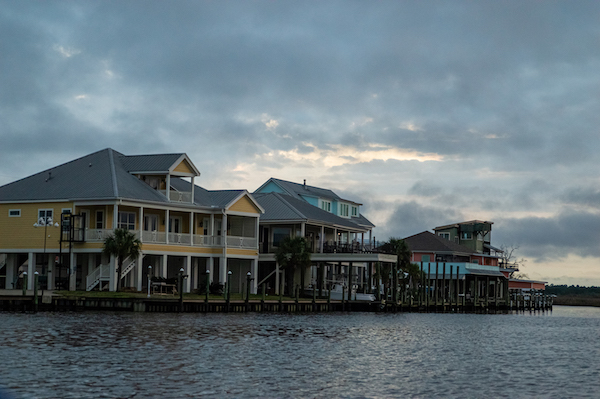Story by Hal Fox
“We’ve had so many disasters that we’ve started living off of disasters,” Lonnie Falgout said on the porch of his raised home while swatting away the evening gnats.
A Cajun from Horneville, La., Falgout served as a city councilman of Bay St. Louis from 2013-2017, representing the sixth ward. He helped to rebuild the town in the aftermath of Hurricane Katrina, which killed 58 people in the small community.
“This area was totally wiped out clean,” Falgout said. “It looked like somebody came in here with a broom and wiped it, and all you saw was slabs.”

Hurricane Katrina devastated Bay St. Louis and the entire Gulfport-Biloxi metropolitan area in 2005, but the town has since recovered to almost double its pre-Katrina population.
“When Katrina hit, we were approaching (a population of) 8,000 people. After Katrina, we dropped down to like 5,000 people because everybody took off with no place to live,” Falgout said. “As we sit here in 2024, Bay St. Louis is on the pinnacle to be 15,000. That’s unheard of. We never thought this little town — ‘a place apart,’ that’s our nickname — would be sitting at 15,000.”
As the population grows, Bay St. Louis and the Mississippi Gulf Coast are inundated with flooding emergencies, largely due to increasingly frequent and severe hurricanes.
“We’re going to hit that wall, sooner or later. We’ve gotta remember, Camille was in 1969 and Katrina was in 2005. That’s a long, long time in between,” Falgout said. “We hit that wall, and Katrina came and hit us in the face and we just slid down back in the hole.”
Floods increase in Hancock County
Emergency Management Agency Director Brian Adam manages Hancock County, a 485-square-mile area. Approximately 150 square miles of this land are classified as low-lying, meaning they are at or below sea level, including the town of Bay St. Louis.
Born and raised in Hancock County, Adam has served as the EMA director since 2003 and worked as a firefighter for 20 years before assuming his current position.
“You have to want to be in this business,” Adam said. “You have to really want to do this job.”
Adam said he has noticed a stark increase in floods since he began his tenure.

Photo by Lyn Moore.
“It’s definitely increased. We can go anywhere from five to 25 to 35 or so (flooding events a year). But on average, probably 20. But we’ve had a lot more than that,” Adam said.
Flooding from storm surges produced by powerful hurricanes is the most severe type of emergency that Adam manages. Because the county has an east-facing shore, it is exceptionally vulnerable to strong winds.
The most common type of flooding in Bay St. Louis is coastal flooding caused by high tides and strong south-eastern winds, and these events can happen at any time of year. Additionally, heavy rains can cause flooding farther north in the county along streams that eventually flow into low-lying areas.
“We have certain areas that flood on heavy rains that don’t flood in coastal flooding. We have a lot of bayous and creeks running through Hancock County. When you have heavy rains up north, everything goes downhill,” Adam said.
Although the problems facing the community are obvious, people in Bay St. Louis are divided on why flooding events have become worse over time.
“I can sit here and tell you that sea level rise is a problem, this is a problem, that’s a problem — but all I can really tell you is that we’ve noticed the increase,” Adam said.
According to the National Oceanic and Atmospheric Administration, the sea level in the Bay St. Louis area is rising by about one inch every two years. While it took 22 years for the sea level to rise by six inches in the area previously, scientists now predict that it will rise by another six inches in only 15 years.
Skeptics question climate change
Residents of the Mississippi Gulf Coast are among the most skeptical of climate change in the United States, with research from Yale University showing that the average number of residents in Hancock, Harrison and Jackson County believing that climate change exists stands at 60% – 12% below the national average. Only 47% of people on the Mississippi Gulf Coast believe this climate change is man-made.
Biloxi Mayor Andrew “FoFo” Gilich has noticed environmental changes in his lifetime, but he is skeptical of the extent of scientists’ ability to understand or correctly assess the severity of climate change.
“This past year, we hit a number of 100-degree plus days in a row. But in the ‘80s we experienced the same thing. I’ve been around a long time, and I’ve seen a lot of hurricanes,” Gilich said. “The one thing I understand, we don’t know as much as we think we know.”
At this point in time, Gilich does not believe that his community is under any sort of existential danger from climate change. He expressed his faith in God, not climate models produced by scientists.
“It’s just the most beautiful day of the year right now in Biloxi. We have our faith in the man up above, and he has a plan, and I don’t know that we understand enough to predict (the extent of climate change),” Gilich said.
Bill Toups, a resident of Bay St. Louis, believes the problem lies with the New Orleans levee system.
“As far as sea level rise, we don’t see any of that. This water level has been the same for 30 years,” Toups said. “The only difference we see is with the south-east winds, and they built all of those levees in New Orleans East and St. Bernard, and there’s nowhere else for that water to go and it kind of falls over this way. As for sea level rise, that’s a bunch of baloney, we don’t see it.”
Emergency Management Agency Director Brian Adam believes the issue is multifaceted.
“People always wanna blame one thing or another — it’s a combination. I have been interviewed so many times about, ‘Oh, it’s gotta be because of the levees.’ Well, I’m sure (the levees) have something to do with that (increased flooding), but it’s not just that,” Adam said. “It’s the barrier islands, it’s sea level rise, it’s a lot of things.
Lonnie Falgout believes that people in the Bay St. Louis community that deny the relevance of other factors beyond the New Orleans levee system continue to ignore the severity of the situation in parts of Bay St. Louis that are prone to flooding. At times, Falgout and others in the community are unable to exit their neighborhoods due to flood waters.
“If they didn’t see the water, they will say, ‘Oh, it didn’t happen.’ But they didn’t think about the nine or 10 days we were stuck back here,” Falgout said. “You’ve got to put the answer in front of people nowadays.”
As more people move in and purchase homes in the community, strong storms and increased flooding events continue to drive up insurance rates or prompt insurance companies to stop writing policies in high-risk areas altogether.
“Insurance has risen over the years, and after Katrina, a lot of people had the trouble of trying to figure out if (their damage) was wind versus water, and to me, I don’t know how you can say it’s one or the other, because both happened,” Adam said. “And that’s where I have an issue with the insurance companies.”
According to research by Capgemini, an information technology company, 74% of insurance executives worry that climate change will exacerbate risks and impact their own cost-benefit analysis when deciding to provide coverage.
Falgout believes insurance companies took advantage of policyholders in the aftermath of Hurricane Katrina.
“All of these insurance companies pulled out,” Falgout said. “We knew that they were blaming the wind and not the water. So they walked away.”
After two whistleblowers let on to the unethical business practices, the government sued State Farm Fire and Casualty Co. for $100 million.
“It’s going to get to the point where the government’s not going to have the money to bail us out,” Falgout said. “The insurance company’s gonna walk away because they can. It’s only gonna take people to unite together and say, ‘We’ve had enough.’ Yes, you’re gonna hit that wall. It’s gonna happen.”
Importance of infrastructure
Falgout believes maintenance and construction are the best ways to protect his community and mitigate rising insurance rates. He thinks that by proactively addressing the floods through infrastructure, Bay St. Louis can buck the trend and drive rates down. Falgout suggested several projects that would mitigate flood damage, including building a retention pond to offset millions of gallons of flood waters and rebuilding the Long Beach seawall.
“Lake Pontchartrain has a 27-mile seawall. They don’t have erosion problems and it’s because of the sea walls protecting them,” Falgout said. “These fools back in the ‘40s, ‘50s and ‘60s – old men like my grandfather – were smart enough to say, ‘We’re gonna put a stop to this.’ And it stopped.”
According to research, seawalls do prevent erosion along their lengths, but erosion typically increases in areas beyond the walls’ ends. So, unless they are built according to a coordinated plan, seawalls simply pass along the effects of the waves, which end up doing more damage at the first unprotected spot.
Falgout believes that addressing climate change and improving infrastructure is important to his community, because the next Katrina could always be right around the corner.
“Here we are trying to regroup again,” Falgout said. “And then Ida came, and then Inez came. We keep getting hit. Sooner or later, we’re going to get the big one again.”
Related Stories:
First Line of Defense: Mississippi Barrier Islands Undergo Restoration
Processor to Plate: Mississippi’s Seafood Industry Struggles
